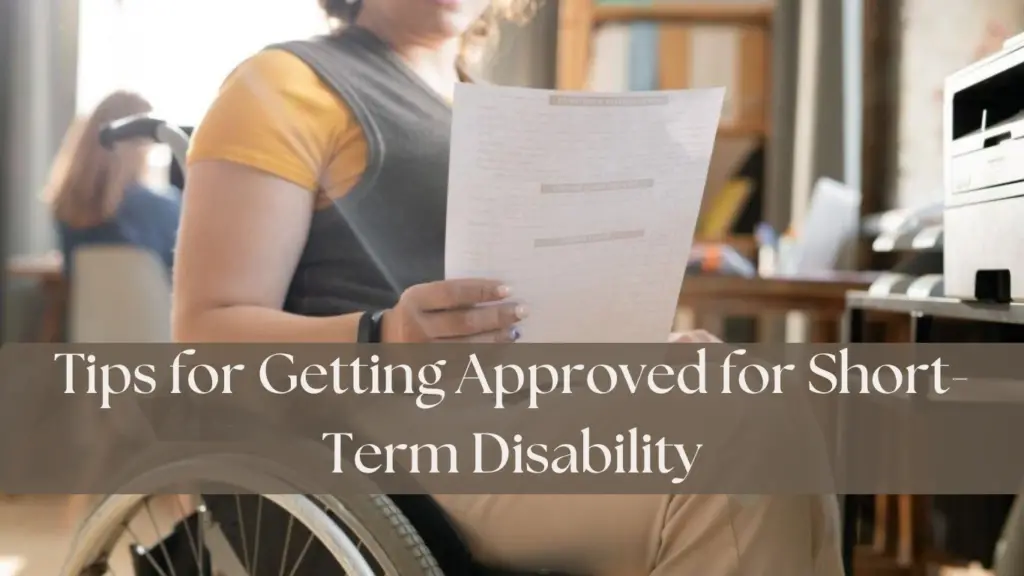In today’s fast-paced world, mental health issues like anxiety and depression are becoming more recognized as legitimate reasons to take time off work. If you’re struggling, it’s essential to know that short-term disability (STD) can provide the support you need to focus on recovery without the added stress of financial instability. However, getting short-term disability approved for anxiety and depression isn’t always straightforward. This guide walks you through the process, offering practical steps and tips to ensure your claim gets the green light.
What Is Short-Term Disability?
Short-term disability is a type of insurance that provides financial benefits if you are temporarily unable to work due to an illness, injury, or medical condition—including mental health conditions like anxiety and depression. The key difference between short-term and long-term disability is the duration of coverage. Short-term disability typically covers you for a few weeks to a few months, depending on your policy.
While physical injuries are often the first thing that comes to mind when people think of disability, mental health issues are just as valid. Depression and anxiety can be debilitating, affecting your ability to perform at work, which is why many insurance providers and employers now include mental health in their disability policies.
Can You Get Short-Term Disability for Anxiety and Depression?
The simple answer is yes. Anxiety and depression are recognized as legitimate reasons to apply for short-term disability. The Americans with Disabilities Act (ADA) and other mental health legislation have paved the way for mental health to be seen as a qualifying disability. However, not every case of anxiety or depression will qualify—you need to demonstrate how it significantly impacts your ability to perform your job duties.
Eligibility Requirements for Short-Term Disability
To be eligible for short-term disability benefits, you need to meet several requirements. These may vary slightly depending on your insurance provider or employer. Generally, you must:
- Be a full-time employee covered by an STD policy
- Have worked for your employer for a certain period (usually 12 months)
- Have a medical certification from a licensed healthcare provider confirming that your anxiety or depression prevents you from working
- Be receiving treatment for your condition
Understanding your specific policy is key since some plans may not cover mental health conditions, or they may require a waiting period before you can receive benefits.
Understanding Anxiety and Depression as Disabilities
Anxiety and depression aren’t just “bad days.” They can severely impair your ability to function, both in daily life and at work. If you’re experiencing symptoms like constant fatigue, trouble concentrating, or an overwhelming sense of dread, these might be strong indicators that your mental health condition is interfering with your job performance.
While there’s still some stigma around mental health, more employers and insurance companies are starting to recognize anxiety and depression as serious conditions. Educating yourself on how these conditions affect your work life is the first step in building a solid case for disability benefits.
Step-by-Step Process for Filing a Short-Term Disability Claim
Here’s a detailed breakdown of how to file your claim and get it approved:
Step 1: Review Your Insurance Policy
Check your insurance policy or employee benefits package to confirm that anxiety and depression are covered. Some policies explicitly mention mental health conditions, while others may be more vague. Know the terms, waiting periods, and the required medical documentation.
Step 2: Consult with a Healthcare Professional
The cornerstone of your disability claim is your healthcare provider’s support. Schedule an appointment with your doctor to discuss your symptoms and how they impact your ability to work. Your doctor will provide an official diagnosis, treatment plan, and medical certification, all of which are critical for your claim.
Step 3: Inform Your Employer or Insurance Provider
Once you have the necessary medical documentation, notify your employer or insurance provider that you’ll be filing a short-term disability claim. They will provide you with the required forms to complete.
Step 4: Submit All Necessary Documentation
Make sure you include all the necessary documents with your claim:
- Medical certification
- Your doctor’s notes and recommendations
- Proof of your ongoing treatment plan
- Any additional forms from your employer or insurer
Step 5: Follow Up on Your Claim
After submitting your claim, follow up with your insurance provider to ensure everything is moving forward. The approval process can take anywhere from a few weeks to over a month, depending on your provider and the complexity of your case.
Tips for Getting Approved for Short-Term Disability

1. Keep Detailed Medical Records: Ensure all your appointments, medications, and treatments are well-documented.
2. Stay in Treatment: Consistency is key. Regular treatment shows that you’re actively addressing your condition.
3. Be Transparent: Be honest about how your condition affects your work life.
4. Follow Up: Stay in communication with your insurance provider and promptly address any requests for additional information.
The Role of Your Doctor in the Approval Process
Your doctor plays a vital role in your claim’s approval. Make sure they understand the short-term disability process and can provide the necessary paperwork. The more detailed and comprehensive their notes, the stronger your case will be.
Common Reasons for Short-Term Disability Claim Denials
It’s not uncommon for mental health claims to be denied due to:
- Insufficient medical documentation
- Incomplete forms
- Lack of clear evidence that your condition affects your work
Avoid these pitfalls by ensuring your claim is thorough and accurate.
What to Do If Your Claim Is Denied
If your claim is denied, don’t panic. You have the right to appeal. Strengthen your appeal by gathering additional documentation or consulting a legal professional experienced in disability claims.
How Long Can You Be on Short-Term Disability for Anxiety and Depression?
Short -term disability usually lasts between 3 to 6 months. If your condition persists, you may need to explore transitioning to long-term disability.
How to Manage Anxiety and Depression During the Claim Process
Waiting for your claim to be approved can be stressful, which may exacerbate your anxiety or depression. Lean on your support system, continue your treatment, and stay positive throughout the process.
The Importance of Self-Advocacy in the Process
You are your best advocate. Stand up for your mental health rights, educate yourself about the process, and don’t hesitate to push back if you feel your condition isn’t being taken seriously.
Conclusion
Getting short-term disability approved for anxiety and depression can be challenging, but it’s absolutely possible with the right preparation and support. Prioritize your mental health, gather solid documentation, and don’t give up. Your health and well-being are worth fighting for.
FAQs
1. Can I reapply for short-term disability if my claim was denied?
Yes, you can file an appeal or reapply if you gather more evidence.
2. How do I know if my anxiety and depression are severe enough for disability?
Consult a healthcare provider to assess whether your symptoms impair your ability to work.
3. Can I get fired while on short-term disability for mental health issues?
Most employers cannot legally fire you while you’re on approved short-term disability.
4. What happens if my employer doesn’t offer short-term disability?
You can explore state-provided benefits or private insurance options.
5. How do I transition from short-term to long-term disability for mental health?
You’ll need further medical evidence and might have to reapply through your insurer for long-term coverage.

